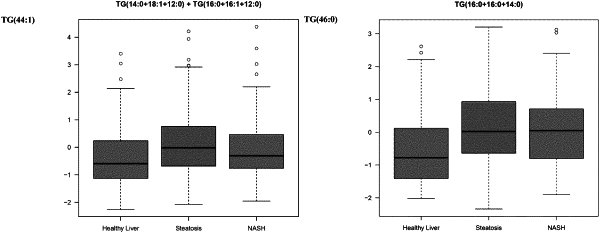| CPC G01N 33/92 (2013.01) [G01N 2405/02 (2013.01); G01N 2560/00 (2013.01); G01N 2570/00 (2013.01); G01N 2800/085 (2013.01)] | 7 Claims |

|
1. A method for discriminating between non-alcoholic steatohepatitis (NASH) and steatosis and correspondingly treating a patient diagnosed with non-alcoholic fatty liver disease (NAFLD), the method comprising:
(i) fractionating by liquid chromatography a sample isolated from the patient;
(ii) determining by mass spectrometry the levels of one or more metabolic markers selected from the group consisting of:
(a) metabolic marker TG(44:1) comprising at least one of analytes TG(14:0+18:1+12:0) and TG(16:0+16:1+12:0);
(b) metabolic marker TG(48:2) comprising at least one of analytes TG(14:0+18:1+16:1) and TG(16:0+18:2+14:0);
(c) metabolic marker TG(49:1) comprising analyte TG(15:0+18:1+16:0);
(d) metabolic marker TG(50:2) comprising at least one of analytes TG(16:0+18:1+16:1), TG(18:1+18:1+14:0), and TG(16:0+18:2+16:0);
(e) metabolic marker TG(51:1) comprising analyte TG(16:0+17:0+18:1);
(f) metabolic marker TG(51:2) comprising analyte TG (16:0+17:1+18:1);
(g) metabolic marker TG(51:3) comprising analyte TG(18:2+18:1+15:0);
(h) metabolic marker TG(52:0) comprising analyte TG(16:0+18:0+18:0);
(i) metabolic marker TG(52:3) comprising analyte TG(16:0+18:1+18:2);
(j) metabolic marker TG(52:4) comprising analyte TG(16:0+18:2+18:2);
(k) metabolic marker TG(53:3) comprising at least one of analytes TG(18:2+18:1+17:0) and TG(18:1+18:1+17:1);
(l) metabolic marker TG(54:2) comprising analyte TG(18:0+18:1+18:1);
(m) metabolic marker TG(54:3) comprising at least one of analytes TG(20:2+20:1+14:0), TG(20:2+18:1+16:0), TG(20:1+18:2+16:0), and TG(18:2+18:1+18:0);
(n) metabolic marker TG(54:5) comprising analyte TG(18:2+18:2+18:1);
(o) metabolic marker TG(54: 6) comprising analyte TG(20: 4+18:2+16: 0);
(p) metabolic marker TG(56:3) comprising analyte TG(18:1+20:1+18:1);
(q) metabolic marker TG(56:7) comprising at least one of analytes TG(22:5+18:2+16:0) and TG(20:4+18:2+18:1); and
(r) metabolic marker TG(56:8) comprising analyte TG(22:6+18:2+16:0),
(iii) generating a predictive score based on relative values of the metabolic markers in a logistic regression model to discriminate between NASH and steatosis, wherein the predictive score is given by formula (I)
 wherein
 ci is the coefficient estimated for the model for the parameter i, wherein each parameter i of the model includes Ai1 and Ai2, wherein Ai1 is a first metabolic marker of (a)-(r) determined in (ii) or a first metabolic marker logarithm, and Ai2 is a second metabolic marker of (a)-(r) determined in (ii), second metabolic marker logarithm, body mass index, or body mass index logarithm and [Ai1] and [Ai2] are corresponding relative values of Ai1 and Ai2 based on metabolic marker levels obtained in (ii); and
(iv) treating the patient for NASH when the predictive score is ≥0.5, and treating the patient for steatosis when the predictive score is <0.5.
|